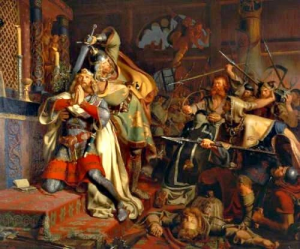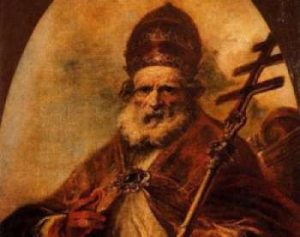 Saint Canute
Saint Canute
King of Denmark, Martyr († 1086)
Feast – January 19
Since the resurrection of Our Lord Jesus, the Roman Empire became a vehicle spreading Christianity through the world bringing blessings of prosperity. In 800, the Frankish king Charlemagne was crowned emperor in Rome by Pope Leo III. This transferred the Roman Empire from east to west and set the foundation for the Holy Roman Empire, which lasted until 1806. Wealthy towns with beautiful churches, monasteries and peaceful communities were desired by neighboring pagans too, but unwilling to discard their idols they saw different ways to assume it. 793 AD to 1066 AD was the period during the Middle Ages when Norsemen from Scandinavia and Denmark, known as Vikings, undertook large-scale raiding to collect significant wealth. This created a need for trade. Viking merchants regarded Christianity as a necessary evil that they had to put up with to be successful in trading. That is why when they went abroad, they would often allow themselves to be marked with the sign of the cross. It is believed that because of the extensive trade networks with Christians the Vikings chose Christianity during the 900s.
In 965 King Harald Bluetooth’s declared Denmark Christian, but the transition to Christianity took place gradually. Even with missionaries doing their best to introduce Christianity traces of the Norse gods were still evident up until the 1200s.
In 1042 St. Canute was born one of the many sons of King Sweyn II Estridsson. He was named after his father’s uncle Canute the Great – King of Denmark, England and Norway, often referred as the North Sea Empire. Sweyn took good care of the education of his son who being endowed with excellent qualities both of mind and body, answered perfectly well the care of his preceptors and governors. St. Canute was first noted as a member of Sweyn’s 1069 raid of England and was one of the leaders of another raid in 1075. As a young prince, he cleared the seas of pirates and subdued several neighboring provinces which were harassing Denmark.
The kingdom of Denmark had an elected ruler until the year 1660. Thus, when Sweyn died, many pitched upon our saint whose eminent virtues best qualified him for the throne, but the majority, fearing his martial spirit, preferred his eldest natural brother Harold, commonly called the Slothful.
St. Canute retired into Sweden to King Halstan, who received him with the greatest marks of kindness and esteem. On the 17th of April, 1080, after two year’s reign Harold died and St. Canute was called to succeed him.
On his accession, he married Alice of Flanders, daughter of Robert, Earl count of Flanders. She bore him one son, Charles (St. Charles the Good, Earl of Flanders) and twin daughters Cæcilia and Ingerid.
He began his reign with a successful war against the troublesome, barbarous enemies of the state, and by planting the faith in the conquered provinces of Courland, Samogitia, and Livonia. His courage rivaled in excellence with his ability in the conduct and skills of war, but his piety surpassed all his other endowments. He chastised his body with fasting, discipline, and hair-cloths. Prayer was his assiduous exercise.
Amid the glory of his victories he humbly prostrated himself at the foot of the crucifix, laying there his diadem, and offering himself and his kingdom to the King of kings.
Denmark was officially a Christian country for over a hundred years but needed a zealous hand at the helm to cement this. St. Canute seemed to have been chosen for that task.
After having provided for the peace and safety of his country and enlarged its territories his next concern was to reform abuses at home. For this purpose, he enacted severe, but necessary laws, for the strict administration of justice, and repressed the violence and tyranny of the great, without respect for status. It became evident when he condemned to death a Danish lord whose vessel, to sustain the owner’s luxury, had pillaged the ship of a neighboring country and massacred the crew.
His charity and tenderness towards his subjects made him study all possible ways to ease them of their burdens.
He honored holy men and granted many privileges and immunities to the clergy. He enhanced the authority of the church and demanded austere observation of church holidays. By building and adorning churches, giving large gifts to the churches in Dalby, Odense, Roskilde, Viborg, Lund, he even donated his very great value crown to the church of Roschild, in Zealand he enhance the people’s esteem to provide for needs of the Church.
When childless English king Edward the Confessor died in 1066, the Norman King William the Conqueror built a large fleet and invaded England in September 1066. He defeated and killed Harold Godwinson the last crowned Anglo-Saxon king of England at the Battle of Hastings on 14 October 1066 and on Christmas day the same year became King of England. He made arrangements for the governance of England in early 1067 before returning to Normandy. Several unsuccessful rebellions followed.
In 1069 St. Canute sent forces to assist the vanquished; but these troops found no one willing to join them and were easily defeated.
Later being invited by the conquered English, he raised an army to expel the Normans: but through the treacherous practices of his brother Olaf, was obliged to wait so long on the coast, that his troops deserted him. The pious king judging this a proper occasion to induce his people to pay tithes to their pastors proposed to them either to pay a heavy fine, by way of punishment for their desertion, or submit to the law of tithes for the pastors of the church.
In early 1086 a revolt broke out in Vendsyssel, where St. Canute was staying, first he fled to Schleswig and eventually to Odense. On 10 July 1086, he and his men took refuge inside the wooden St. Alban’s Priory, in Odense. Perceiving his danger, he confessed his sins at the foot of the altar and received Holy Communion. Stretching out his arms before the altar fervently recommended his soul to his Creator. According to the chronicler Ælnoth of Canterbury he died down on his knees following a lance thrust in the flank. His brother Benedict, and seventeen others, were slain with him.
Olaf succeeded him in the kingdom. God punished the people during the eight years and three months of his reign with crop failure, dreadful famine, and other calamities. According to Arild Hvitfeldt’s “Danmarks Riges Krønike”, in those years springtime was so dry that the fields looked as if they had been burned, and in the fall the skies opened up and rain fell so often that people floated about on pieces of wood to cut the heads off the grain that rose above the water; the hunger of the people grew so great that they dug the earth looking for roots. The wealthy grew thin, and the poor died of starvation. At the same time sanctity of the martyr was attested by many miraculous cures of the sick at his tomb. For this reason his relics were taken up out of their obscure sepulchre, and honourably entombed and his canonization was already being sought before the end of the reign of Olaf.
His successor, Eric I the Good restored piety and religion in Denmark and sent ambassadors to Rome, with proofs of the miracles performed. On 19 April 1101 Pope Paschal II confirmed the “cult of Canute” that had arisen, and King Canute IV was canonized as a saint under the name San Canuto.
References and Excerpts:
[1] O. I. H. depicting K. O. Ik. of D.-1095PredecessorCanute I. the H. I. E. 1050Died18 A. 1095ConsortIngegerd of N. U. nameOlaf S. I. E. Catholicism, “WikiVisually.com.” http://wikivisually.com (accessed Jan. 09, 2021).
[2] “Saint Canutus, King of Denmark, Martyr.” https://sanctoral.com/en/saints/saint_canutus.html (accessed Jan. 09, 2021).
[3] “Butler’s Lives of the Saints – Saint Canutus, King of Denmark, Martyr,” CatholicSaints.Info, Jan. 18, 2013. https://catholicsaints.info/butlers-lives-of-the-saints-saint-canutus-king-of-denmark-martyr/ (accessed Jan. 09, 2021).
[4] “Canute IV of Denmark,” Wikipedia. Dec. 29, 2020, Accessed: Jan. 09, 2021. [Online]. Available: https://en.wikipedia.org/w/index.php?title=Canute_IV_of_Denmark&oldid=997083466.
 Saint Damasus
Saint Damasus